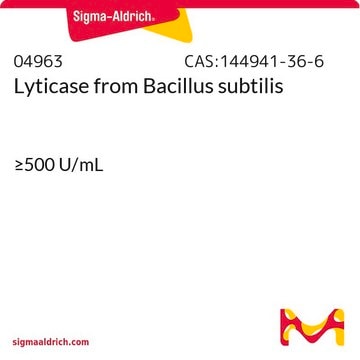The milligram quantity of this product will vary from lot to lot. The vial content is dependent upon the protein content and enzymatic activity. The minimum protein content will be 20% and the minimum activity will be 2000 units per milligram of protein. As an example, a batch that reports a protein content of 20% and an activity of 5000 units per milligram protein will have a vial content of 2 mg for the 10,000 unit package size. The protein content and activity are reported in the product Certificate of Analysis. Please see the link below to review a sample or lot specific Certificate:
https://www.sigmaaldrich.com/product/sigma/l2524#product-documentation
L2524
Lyticase from Arthrobacter luteus
lyophilized powder, ≥2,000 units/mg protein, Protein ≥20 % by biuret
Sinónimos:
(1,3)-β-D-Glucan endohydrolase, 1,3-β-Glucan glucohydrolase, Bacterial lyticase, Lysing enzyme
Seleccione un Tamaño
131,00 €
Seleccione un Tamaño
About This Item
131,00 €
Productos recomendados
origen biológico
bacterial (Arthrobacter luteus)
Nivel de calidad
Formulario
lyophilized powder
actividad específica
≥2,000 units/mg protein
composición
Protein, ≥20% biuret
técnicas
cell based assay: suitable
idoneidad
suitable for cell lysis
aplicaciones
diagnostic assay manufacturing
temp. de almacenamiento
−20°C
¿Está buscando productos similares? Visita Guía de comparación de productos
Categorías relacionadas
Aplicación
- for spheroplasting the cells
- as a component of digestion solution to incubate yeast cells for digestion of the cell wall
- in the enzymatic hydrolysis of the mycelium precipitate to prepare protoplasts
Acciones bioquímicas o fisiológicas
Definición de unidad
Forma física
Otras notas
Palabra de señalización
Danger
Frases de peligro
Consejos de prudencia
Clasificaciones de peligro
Resp. Sens. 1
Código de clase de almacenamiento
11 - Combustible Solids
Clase de riesgo para el agua (WGK)
WGK 3
Punto de inflamabilidad (°F)
Not applicable
Punto de inflamabilidad (°C)
Not applicable
Equipo de protección personal
Eyeshields, Gloves, type N95 (US)
Elija entre una de las versiones más recientes:
Certificados de análisis (COA)
¿No ve la versión correcta?
Si necesita una versión concreta, puede buscar un certificado específico por el número de lote.
¿Ya tiene este producto?
Encuentre la documentación para los productos que ha comprado recientemente en la Biblioteca de documentos.
Los clientes también vieron
Protocolos
This procedure may be used for the determination of Lyticase activity using Baker’s yeast as the substrate.
-
How many milligrams is 10,000 units of Product L2524 Lyticase from Arthrobacter luteus?
1 respuesta-
¿Le ha resultado útil?
-
-
Is it purified downstream by affinity chromatography or is it just an ammonium sulfate precipitate?
1 respuesta-
This product is purified by conventional chromatography following the initial ammonium sulfate precipitation process.
¿Le ha resultado útil?
-
-
What is the recommended working concentration of L2524, if a typical 10mg/ml concentration of L1412 is used?
1 respuesta-
There have been no tests conducted for product L2524 application on the fungus Aspergillus fumigatus. However, according to a citation in Vet Pathol, 2U/100 ul of fungal extraction has shown good results. The citation is titled "Panfungal Polymerase Chain Reaction for Identification of Fungal Pathogens in Formalin-Fixed Animal Tissues" and was published in July 2017. The DOI is 10.1177/0300985817698207, and the PMID is 28346123
¿Le ha resultado útil?
-
-
What is the molecular weight of this product?
1 respuesta-
The molecular weight of Lyticase has not been determined.
¿Le ha resultado útil?
-
-
What is the molecular weight of this product?
1 respuesta-
The molecular weight of Lyticase is not determined.
¿Le ha resultado útil?
-
-
I see it is suggested to reconstitute Lyticase fresh. However, if that is not possible, can you store reconstituted Lyticase, L2524, at -20C? If so, for how long?
1 respuesta-
The solution stability of this product has not been determined. However, according to Cold Spring Harbor Protocols, lyticase may be stored up to 6 months at 4 deg. C when prepared in 10 mM Tris-CL containing 20% glycerol. This has not been validated. See the link below to this citation:
https://cshprotocols.cshlp.org/content/2017/2/pdb.rec090381.full?rss=1¿Le ha resultado útil?
-
-
How can I store Product L2524, Lyticase, once reconstituted?
1 respuesta-
When lyticase is reconstituted and stored, it may be stable for no more than 4-6 hours before serious loss of activity is observed. It is suggested that fresh solutions be prepared for use.
¿Le ha resultado útil?
-
-
How do I solubilize Product L2524, Lyticase?
1 respuesta-
The quality control enzymatic assay protocol for Lyticase uses cold deionized water to make a solution at 500 units/mL.
¿Le ha resultado útil?
-
-
How can Product L2524, Lyticase, be used to make yeast spheroplasts?
1 respuesta-
The use of lyticase in combination with chitinase and glucuronidase in the preparation of spheroplasts from C. albicans has been described in the following reference: Calvert, C.M., and Sanders, D., "Inositol Trisphosphate-dependent and -independent Ca2+ Mobilization Pathways at the Vacuolar Membrane of Candida albicans". J. Biol. Chem. 270, 7272-7280 (1995).
¿Le ha resultado útil?
-
-
What is the Department of Transportation shipping information for this product?
1 respuesta-
Transportation information can be found in Section 14 of the product's (M)SDS.To access the shipping information for this material, use the link on the product detail page for the product.
¿Le ha resultado útil?
-
Filtros activos
Nuestro equipo de científicos tiene experiencia en todas las áreas de investigación: Ciencias de la vida, Ciencia de los materiales, Síntesis química, Cromatografía, Analítica y muchas otras.
Póngase en contacto con el Servicio técnico








